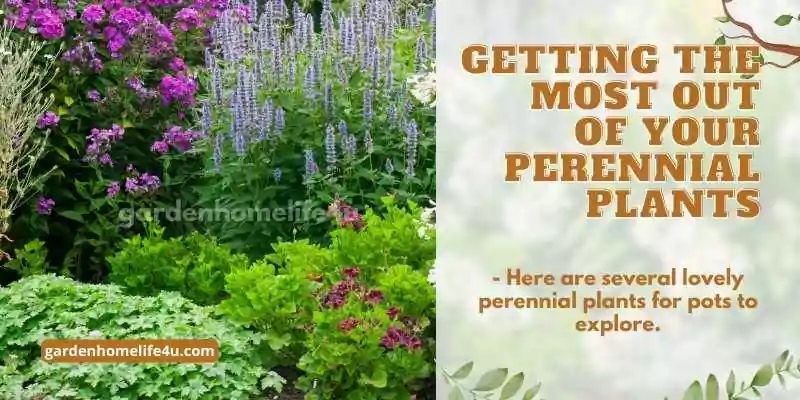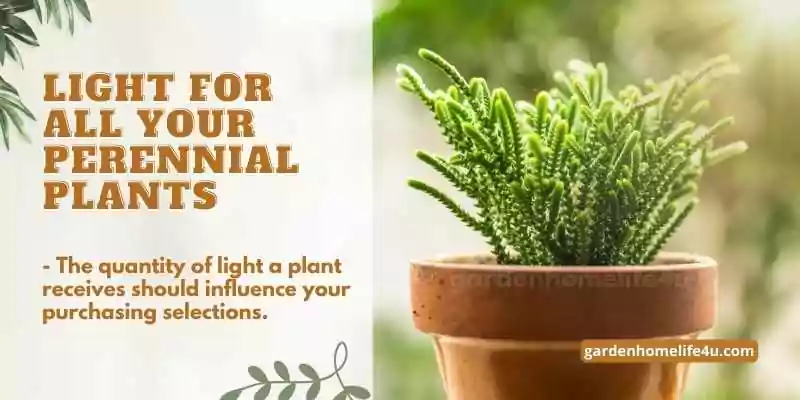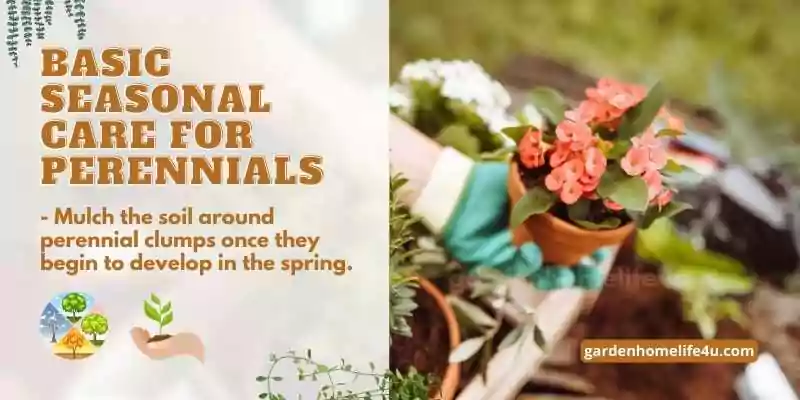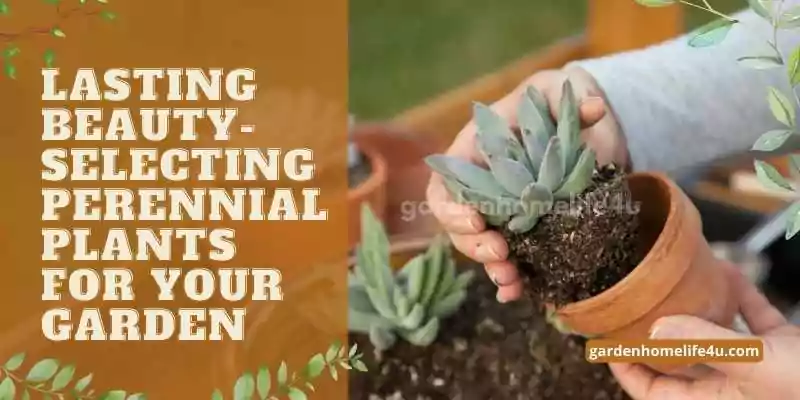Imagine a garden that evolves with the passing seasons, each bloom revealing a new chapter in the story of nature’s splendor. Perennial plants, nature’s gifted storytellers, take center stage, offering a kaleidoscope of blossoms, foliage, and enchanting scents throughout the year. These steadfast beauties, with their ability to regenerate year after year, ensure your landscape remains vibrant, alive, and ever-changing.
In this guide, we delve into the art of selecting perennial plants that embrace your garden with a symphony of colors and textures throughout the seasons. If If you’re a novice gardener eager to embark on your first horticultural adventure, our expert tips and insights will serve as your compass in this blossoming pursuit. Together, we’ll explore the criteria for choosing perennial plants that harmonize with your unique garden vision. From early spring’s first buds to winter’s resilient evergreens, we’ll uncover the diverse array of options available to create an enduring oasis of year-round beauty.
As the name suggests are plants that can live and keep growing year after year. They can further be classed as herbaceous which means they will die in winter and come back next spring. Bear in mind that evergreens are plants that are not affected by weather and essentially live throughout the year with the leaves on although they only flower in a particular season. Perennial plants will grow flowers in the appropriate season as well year after year. Technically a plant can be called perennial if it lasts for at least 3 years.
Perennials are one o the main constituents of any Garden, flower beds, or borders. They are reliable plants and they will flower in different seasons, some will flower in spring, some in Autumn, and even in winter making them a wonderful choice for the garden and year around variation and presence of flowers and a multitude of colors.
A hardy perennial is a perennial which will grow, flowers and come back after year after year. There are also half-hardy perennials which are only called perennials in the particular region or locality where they are grown. These half-hardy perennials can be grown in colder regions such as the UK but they will not survive our tough winters they are only suitable for temperature in the regions of 8 to 12 degrees centigrade.
Some of the perennial plants can be very temperamental and sometimes do not like the Covered ground or congestion around them. When you are using mulch of any kind make sure that you do not cover the actual plant and try to go around it. The basic purpose of the mulch is to discourage all the unwanted herbs and weeds to come out of the ground and that is exactly what to do for perennial plants.
A common question that is asked frequently is when and how to divide plants. When we say dividing, the plant has to be lifted away and actually and literally divided using a spade and right in the middle of it all the way to the root creating sections of plants that can then be planted separately. Dividing is a healthy process especially for the plant beds because they spread over a relatively larger area. The same principle applies to perennials, they need division when the time comes. As to the timing of the division, you need to observe them carefully and see if they are wilting in the middle or sides. Any wilting or dry areas would indicate plant division is required, with as many sections as needed. Generally, every two to three years, it is advised to perform division on perennials’ beds.
We all want plants that bloom the best and longest. There are quite a few perennials that bloom considerably really good a long time like Napeta would bloom for a pretty long period. Geum is also another good example of a long blooming period.
Hardy geraniums are another good example and one of the favorite go-to plants for longer bloom periods.
Geranium is also goto perennials which are shade-friendly plants. Hellebores is another great choice for shades.
Perennial plants are the bedrock of any garden. A lovely, flowering perennial garden may be the centerpiece of your garden while also providing attractive cut flowers for bouquets. Long-lived perennials are more expensive than annuals, but they are well worth the investment. The plants’ tops die in the winter, but they regrow from their roots the very next spring or summer. They usually take a few years to solidify themselves, so don’t be disheartened if they appear uninteresting for the first year or two. They’re establishing a root system that will allow them to return year after year, larger and better. Many perennials are low-maintenance, but they all need some pampering to look their best.
Perennial plants in pots, on the other hand, are considerably easier to care for. They are initially more expensive than bedding, but they develop into large plants. They ought to be able to endure several years in a container before being grown in the garden. Since many perennials aren’t as flashy as annuals, the challenge is to choose plants with long-lasting blooms as well as beautiful leaves or intriguing textures.
Tip: Try to grow them in big pots with good multi-purpose compost and plenty of water.
Getting the Most Out of Your Perennial Plants

Here are several lovely perennial plants for pots to explore.
Daylilies
Daylily blossoms last only a day, yet they generate bloom after bloom, providing a show for several weeks. Every three or four years, divide or replace daylilies to keep the roots from becoming clogged and maintain the finest flower show!!
Salvia nemorosa
Salvia nemorosa is a hardy perennial that produces an abundance of purple flower spikes from summer through fall, providing a long season of pleasure. Growing in hot, arid climates, Salvia plants are ideal for hot, sunny weather, and once grown, they are drought tolerant. Salvia makes a great view in a mixed border or when planted with grasses.
Lavender
Lavender is one of our favorite perennials. This hardy, evergreen shrub is great for bordering, fencing, gardens, and pots because of its fragrant summer blooms and scented leaves. The blooms are very appealing to bees and butterflies, and they can withstand dryness and thrive in light, sandy soils.
Do you know?
They also produce fantastic cut flowers, as well as cake flavoring essence and deodorant.
Best Border Perennial Plants
Here are lovely border perennials to explore:
Snowdrop Anemones
White petals and a pale yellow central eye define this fragile, beautiful little flower, which blooms in late spring to early summer. It has a fern-like leaf cluster towards the bottom. Snowdrop anemones make a great ground cover because they bloom in large clusters, making them ideal for covering tulip bulbs before they bloom. This is a fast-growing plant that grows best in full sun.
Plumbago
Plumbago is a beautiful flower that is also known as the sky flower because of its sky-blue color. Although it is essentially a shrub, it produces a large number of sweet-smelling flowers. It blooms continuously, making it an ideal border flower.
Shasta daisy
The wild daisy has been upgraded into the Shasta daisy. It’s distinct because the bloom is bigger and the petals are fuller. They are a very popular border plant since they bloom rapidly and persist for a long time. Shasta daisies, like wild daisies, have a halo of white petals surrounding a central yellow eye.
Light for all your perennial plants

What kind of light will your perennials receive?
The quantity of light a plant receives should influence your purchasing selections. Simply stand in the appropriate growth area and observe where the sun is at different times of the day to calculate how much light a plant will receive.
Most perennials require full sun for the majority of the day, although others are natural woodlanders who thrive in shaded areas.
Here are a few shade-tolerant varieties:
· Hosta
· Primula
This is all about perennials, but what if in case you are unaware of caring for your lovelies (perennials). So, let’s quickly dive in with the basic seasonal care for your perennials.
Basic seasonal care for perennials

- Mulch the soil around perennial clumps once they begin to develop in the spring. Crowns should not be covered. Grass clippings, shredded leaves, compost, wood chips, and other materials can be used. Mulch keeps the soil moist and the roots cool, as well as prevents weed development, and adds a layer of compost to promote future growth.
- To protect taller perennials from wind damage, stake them. Plants should be tied up as they grow.
- Remove dead flower heads and stems after perennials have stopped blooming flowers, to keep the plants from laying seed and to retain their vigor. To keep the foliage growing, use a slow-release fertilizer. This will ensure that the following year’s growth and bloom are healthy.
4. In the fall, trim stems down to 3-4 inches above crowns to allow perennial plants to die back to the roots. But in the early spring, the clump will sprout new growth.
- Most perennials can be split every two or three years to provide a steady supply of new plants. Plants should be split before they get overcrowded to maintain their healthy. Cut the head of each perennial into numerous parts, each with its root system with a sharp knife. Mulch perennials generously protect them from the elements over the winter.
What sort of perennials do you want? How tall and broad do you want them to grow?
Perennials come in a variety of sizes and forms. Tall varieties are appropriate for the back of a border, while short, spreading varieties are ideal for the front.
Because perennials grow at different rates, planting a tall perennial in front of a short perennial will hide the shorter plant if they both bloom at the same time.
Size-based variety suggestions:
Bergenia, Prunella, Veronica, etc. are Edging plants while Aconitum, Aster, Delphinium, Verbascum, etc. are tall plants
So, what makes a perennial plant perfect in the first place?
- It must have the correct color, form, and bloom at the appropriate time and for an extended period!
- It should “act” in the garden in the manner that you want.
How to Design a Perennial Garden
1. Begin planting perennials as soon as your shipment arrives. Pick a spot where water drains rapidly after a rainstorm. Loosen and turn the soil to an 8-inch depth to prepare your planting bed. Remove big clumps of grass and large stones from the soil with a rake.
2. Add peat moss or compost the soil and work it in. Test your soil to see if it has any special requirements.
3. Drill a hole slightly bigger than the root ball for each plant. Set each plant’s crown level with or slightly below the surrounding soil’s level. Fill in around the roots with fine dirt and softly compact it, leaving a plant to catch and retain water.
4. Don’t forget to water your perennials. Fill the tray around each plant with roughly a quart of water. Rehydrate by adding more water and allowing it to sink in. Fill up the area around the cluster with loose, fine dirt.
5. Mulch if you live in a chilly environment. Mulch perennial clumps when the earth has frozen solid in late autumn. You can use salt hay, straw, or evergreen branches that will not compact. Eliminate the winter mulch in the spring season. Do remember!!
Ways to plant perennials in your backyard
Perennial flowers and plants can be planted in your backyard in three convenient ways:
Seeds: Growing perennials from seeds are the easiest way, but it is also the most challenging. If you put your seeds outside after the last frost, you’ll have to wait until late in the season to see any progress. Starting your perennials indoors, in pots, throughout the winter months, and then transplanting them into your outside landscape when the weather warms up may be your best option.
Container-grown perennials: These are the flowers and plants you find at your local garden center, pre-planted in plastic pots or trays. They are the easiest option for planting perennial flowers. Simply dig a bigger hole in the container, remove the plant from its container, and place it in the hole, covering it with soil. After you’ve planted it, make sure to water it.
Bare root perennials: Plants that are pulled up from growing fields while their roots are dormant, packed, and kept cool until they arrive at your garden center. Plant them after the last frost in the spring, when temperatures are between 45°F and 60°F. Dig a hole twice as broad and deep as the root ball when planting a bare-root perennial. Make a hump in the hole’s center, then lay the root ball on top of it and spread the roots out. After you’ve planted your plant, give it plenty of water.
The end,
Perennial gardening is simple and enjoyable. You love fascinating gardens. So do we. Let’s pair each delight with new bloom. Cheers to your new bloom and happy gardening.
Thank You!!

